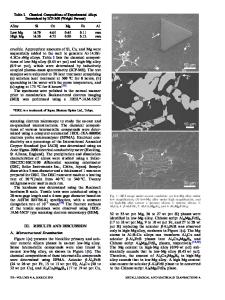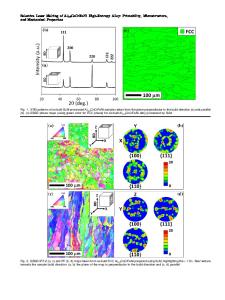Effects of Mo-doping on the microstructure and mechanical properties of CoCrNi medium entropy alloy
- PDF / 1,443,816 Bytes
- 11 Pages / 584.957 x 782.986 pts Page_size
- 101 Downloads / 402 Views
Effects of Mo-doping on the microstructure and mechanical properties of CoCrNi medium entropy alloy Na Li1, Ji Gu1,a) , Bin Gan2, Qiao Qiao2, Song Ni1, Min Song1 1
State Key Laboratory of Powder Metallurgy, Central South University, Changsha 410083, P.R. China Beijing Key Laboratory of Advances High Temperature Materials, Central Iron and Steel Research Institute, Beijing 100081, P.R. China a) Address all correspondence to this author. e-mail: [email protected] 2
Received: 23 June 2020; accepted: 1 September 2020
The CoCrNiMox (x = 0, 0.1, and 0.2 in molar ratio) medium entropy alloys (MEAs) were fabricated by vacuum arc melting, followed by cold rolling and annealing treatments. The X-ray diffraction (XRD), electron back-scattered diffraction (EBSD), and transmission electron microscopy (TEM) were employed to characterize the microstructures. It has been shown that the CoCrNi MEA has a single FCC phase and the Mo-containing MEAs contain (Cr, Mo)-rich σ precipitates. In addition, the Mo addition caused significant grain refinement, due to the fact that the presence of σ phase exerts a strong pinning effect on the grain boundary migration. The hardness testing results indicate an increment in Vickers hardness from 187.5 ± 4.5 Hv of CoCrNi alloy to 309.5 ± 10.3 Hv of CoCrNiMo0.2 alloy. The yield strength and ultimate tensile strength also increase from 339 ± 2 to 644 ± 5 MPa and from 810 ± 5 to 1071 ± 17 MPa, respectively, but the elongation drops from 88.4 ± 4.0% to 29.5 ± 7.6%. The grain refinement and the precipitation of σ phase make synergistic contribution to the reinforcement of Mo-containing CoCrNi-based MEAs. The details and explanations in this study may guide the future design and research of the CoCrNi-based quaternary alloys with enhanced properties.
Introduction High-entropy alloys (HEAs) are a mixed combination of five or more metal elements with an equiatomic or near-equiatomic proportion to surmount the enthalpy of compounds, by controlling the element constituents to obtain the enlarged configurational entropy [1, 2]. Four kinds of effects, described as high-entropy effect, sluggish-diffusion effect, cocktail effect, and severe-lattice distortion effect, allow the multicomponent alloys to possess remarkable properties [3]. Because of the high thermal stability, prominent temperature oxidation resistance, brilliant mechanical properties, and application value, HEAs have become the focus of current studies in materials science and solid-state physics [4, 5, 6, 7, 8, 9]. Similar to the alloy design strategies of HEAs, medium entropy alloys (MEAs), made up of two to four elements [3], have attracted more and more attention due to their exceptional mechanical properties [10, 11, 12, 13]. Laplanche et al. [14] reported that the tensile properties of CrNiCo MEA are superior to those of CrMnFeCoNi HEA. Based on Peierls–Nabarro (P-N) formalism [15], a twinning nucleation P-N model was constructed and applied to predict the twinning critical resolved shear stress
(CRSS), which could evaluate the streng
Data Loading...











